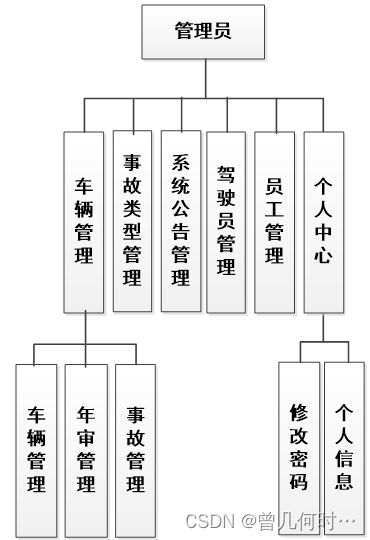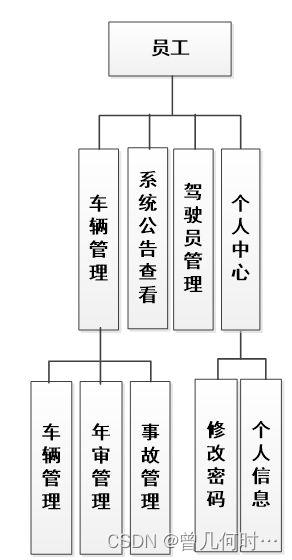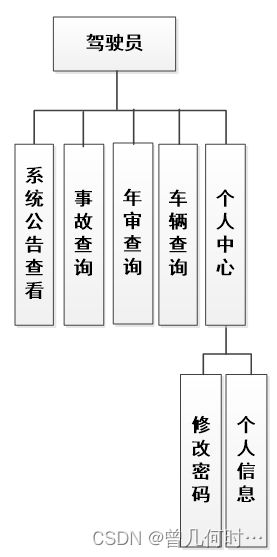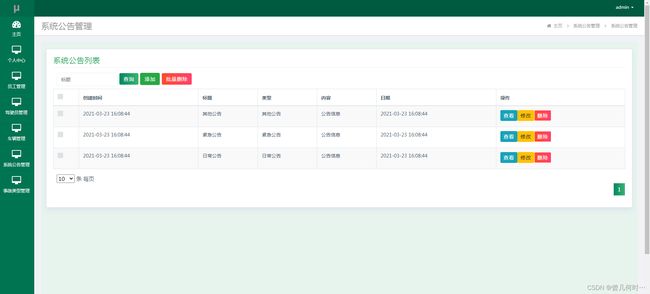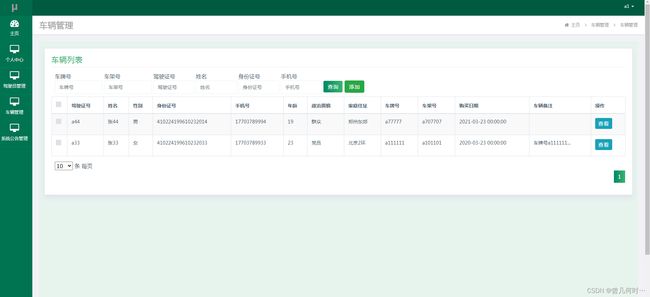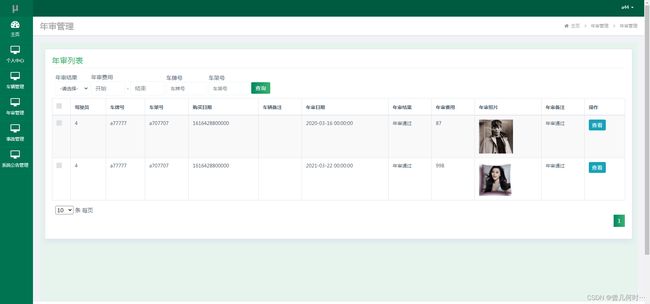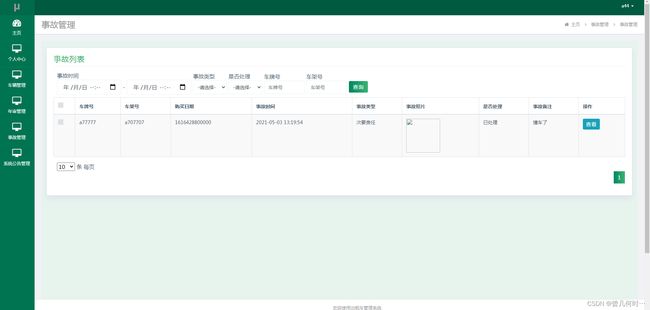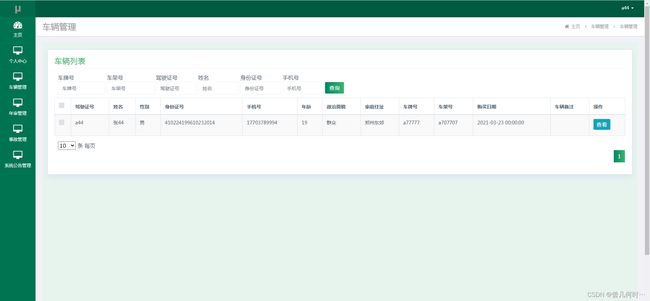基于SSM的出租车管理系统的设计与实现
末尾获取源码
开发语言:Java
Java开发工具:JDK1.8
后端框架:SSM
前端:采用JSP技术开发
数据库:MySQL5.7和Navicat管理工具结合
服务器:Tomcat8.5
开发软件:IDEA / Eclipse
是否Maven项目:是
目录
一、项目简介
二、系统功能
三、系统项目截图
管理员功能实现
员工功能实现
编辑 驾驶员功能实现
四、核心代码
登录相关
文件上传
封装
五、结论
一、项目简介
网络技术和计算机技术发展至今,已经拥有了深厚的理论基础,并在现实中进行了充分运用,尤其是基于计算机运行的软件更是受到各界的关注。加上现在人们已经步入信息时代,所以对于信息的宣传和管理就很关键。因此出租车信息的管理计算机化,系统化是必要的。设计开发出租车管理系统不仅会节约人力和管理成本,还会安全保存庞大的数据量,对于出租车信息的维护和检索也不需要花费很多时间,非常的便利。
出租车管理系统是在MySQL中建立数据表保存信息,运用SSM框架和Java语言编写。并按照软件设计开发流程进行设计实现。系统具备友好性且功能完善。本系统实现了车辆管理,年审管理,事故管理,驾驶员管理等功能。
出租车管理系统在让出租车信息规范化的同时,也能及时通过数据输入的有效性规则检测出错误数据,让数据的录入达到准确性的目的,进而提升出租车管理系统提供的数据的可靠性,让系统数据的错误率降至最低。
二、系统功能
当前,系统的类型有很多,从系统呈现的内容来看,系统的类型有社交类,有商业类,有政府类,有新闻类等。那么,在众多系统类型中,先明确将要设计的系统的类型才是系统设计的首要工作,然后在此基础上明确系统的用户群,功能等,针对这些信息设计出具有独特体验和视觉的系统。如此才能让系统比较具有特色,也能够在众多相似系统中给用户留下深刻印象。
设计的管理员的详细功能见下图,管理员登录进入本人后台之后,管理驾驶员,员工,事故类型,车辆与年审信息。
设计的员工的详细功能见下图,员工管理车辆,登记年审与事故信息,查看公告。
设计的驾驶员的详细功能见下图,驾驶员查询车辆,年审,事故,查看公告。
三、系统项目截图
管理员功能实现
员工功能实现
 驾驶员功能实现
驾驶员功能实现
四、核心代码
登录相关
package com.controller;
import java.util.Arrays;
import java.util.Calendar;
import java.util.Date;
import java.util.Map;
import javax.servlet.http.HttpServletRequest;
import org.springframework.beans.factory.annotation.Autowired;
import org.springframework.stereotype.Controller;
import org.springframework.web.bind.annotation.GetMapping;
import org.springframework.web.bind.annotation.PathVariable;
import org.springframework.web.bind.annotation.PostMapping;
import org.springframework.web.bind.annotation.RequestBody;
import org.springframework.web.bind.annotation.RequestMapping;
import org.springframework.web.bind.annotation.RequestParam;
import org.springframework.web.bind.annotation.ResponseBody;
import org.springframework.web.bind.annotation.RestController;
import com.annotation.IgnoreAuth;
import com.baomidou.mybatisplus.mapper.EntityWrapper;
import com.entity.TokenEntity;
import com.entity.UserEntity;
import com.service.TokenService;
import com.service.UserService;
import com.utils.CommonUtil;
import com.utils.MD5Util;
import com.utils.MPUtil;
import com.utils.PageUtils;
import com.utils.R;
import com.utils.ValidatorUtils;
/**
* 登录相关
*/
@RequestMapping("users")
@RestController
public class UserController{
@Autowired
private UserService userService;
@Autowired
private TokenService tokenService;
/**
* 登录
*/
@IgnoreAuth
@PostMapping(value = "/login")
public R login(String username, String password, String captcha, HttpServletRequest request) {
UserEntity user = userService.selectOne(new EntityWrapper().eq("username", username));
if(user==null || !user.getPassword().equals(password)) {
return R.error("账号或密码不正确");
}
String token = tokenService.generateToken(user.getId(),username, "users", user.getRole());
return R.ok().put("token", token);
}
/**
* 注册
*/
@IgnoreAuth
@PostMapping(value = "/register")
public R register(@RequestBody UserEntity user){
// ValidatorUtils.validateEntity(user);
if(userService.selectOne(new EntityWrapper().eq("username", user.getUsername())) !=null) {
return R.error("用户已存在");
}
userService.insert(user);
return R.ok();
}
/**
* 退出
*/
@GetMapping(value = "logout")
public R logout(HttpServletRequest request) {
request.getSession().invalidate();
return R.ok("退出成功");
}
/**
* 密码重置
*/
@IgnoreAuth
@RequestMapping(value = "/resetPass")
public R resetPass(String username, HttpServletRequest request){
UserEntity user = userService.selectOne(new EntityWrapper().eq("username", username));
if(user==null) {
return R.error("账号不存在");
}
user.setPassword("123456");
userService.update(user,null);
return R.ok("密码已重置为:123456");
}
/**
* 列表
*/
@RequestMapping("/page")
public R page(@RequestParam Map params,UserEntity user){
EntityWrapper ew = new EntityWrapper();
PageUtils page = userService.queryPage(params, MPUtil.sort(MPUtil.between(MPUtil.allLike(ew, user), params), params));
return R.ok().put("data", page);
}
/**
* 列表
*/
@RequestMapping("/list")
public R list( UserEntity user){
EntityWrapper ew = new EntityWrapper();
ew.allEq(MPUtil.allEQMapPre( user, "user"));
return R.ok().put("data", userService.selectListView(ew));
}
/**
* 信息
*/
@RequestMapping("/info/{id}")
public R info(@PathVariable("id") String id){
UserEntity user = userService.selectById(id);
return R.ok().put("data", user);
}
/**
* 获取用户的session用户信息
*/
@RequestMapping("/session")
public R getCurrUser(HttpServletRequest request){
Long id = (Long)request.getSession().getAttribute("userId");
UserEntity user = userService.selectById(id);
return R.ok().put("data", user);
}
/**
* 保存
*/
@PostMapping("/save")
public R save(@RequestBody UserEntity user){
// ValidatorUtils.validateEntity(user);
if(userService.selectOne(new EntityWrapper().eq("username", user.getUsername())) !=null) {
return R.error("用户已存在");
}
userService.insert(user);
return R.ok();
}
/**
* 修改
*/
@RequestMapping("/update")
public R update(@RequestBody UserEntity user){
// ValidatorUtils.validateEntity(user);
userService.updateById(user);//全部更新
return R.ok();
}
/**
* 删除
*/
@RequestMapping("/delete")
public R delete(@RequestBody Long[] ids){
userService.deleteBatchIds(Arrays.asList(ids));
return R.ok();
}
}
文件上传
package com.controller;
import java.io.File;
import java.io.FileNotFoundException;
import java.io.IOException;
import java.util.Arrays;
import java.util.Date;
import java.util.HashMap;
import java.util.List;
import java.util.Map;
import java.util.Random;
import java.util.UUID;
import org.apache.commons.io.FileUtils;
import org.apache.commons.lang3.StringUtils;
import org.springframework.beans.factory.annotation.Autowired;
import org.springframework.http.HttpHeaders;
import org.springframework.http.HttpStatus;
import org.springframework.http.MediaType;
import org.springframework.http.ResponseEntity;
import org.springframework.util.ResourceUtils;
import org.springframework.web.bind.annotation.PathVariable;
import org.springframework.web.bind.annotation.RequestBody;
import org.springframework.web.bind.annotation.RequestMapping;
import org.springframework.web.bind.annotation.RequestParam;
import org.springframework.web.bind.annotation.RestController;
import org.springframework.web.multipart.MultipartFile;
import com.annotation.IgnoreAuth;
import com.baomidou.mybatisplus.mapper.EntityWrapper;
import com.entity.ConfigEntity;
import com.entity.EIException;
import com.service.ConfigService;
import com.utils.R;
/**
* 上传文件映射表
*/
@RestController
@RequestMapping("file")
@SuppressWarnings({"unchecked","rawtypes"})
public class FileController{
@Autowired
private ConfigService configService;
/**
* 上传文件
*/
@RequestMapping("/upload")
public R upload(@RequestParam("file") MultipartFile file,String type) throws Exception {
if (file.isEmpty()) {
throw new EIException("上传文件不能为空");
}
String fileExt = file.getOriginalFilename().substring(file.getOriginalFilename().lastIndexOf(".")+1);
File path = new File(ResourceUtils.getURL("classpath:static").getPath());
if(!path.exists()) {
path = new File("");
}
File upload = new File(path.getAbsolutePath(),"/upload/");
if(!upload.exists()) {
upload.mkdirs();
}
String fileName = new Date().getTime()+"."+fileExt;
File dest = new File(upload.getAbsolutePath()+"/"+fileName);
file.transferTo(dest);
FileUtils.copyFile(dest, new File("C:\\Users\\Desktop\\jiadian\\springbootl7own\\src\\main\\resources\\static\\upload"+"/"+fileName));
if(StringUtils.isNotBlank(type) && type.equals("1")) {
ConfigEntity configEntity = configService.selectOne(new EntityWrapper().eq("name", "faceFile"));
if(configEntity==null) {
configEntity = new ConfigEntity();
configEntity.setName("faceFile");
configEntity.setValue(fileName);
} else {
configEntity.setValue(fileName);
}
configService.insertOrUpdate(configEntity);
}
return R.ok().put("file", fileName);
}
/**
* 下载文件
*/
@IgnoreAuth
@RequestMapping("/download")
public ResponseEntity download(@RequestParam String fileName) {
try {
File path = new File(ResourceUtils.getURL("classpath:static").getPath());
if(!path.exists()) {
path = new File("");
}
File upload = new File(path.getAbsolutePath(),"/upload/");
if(!upload.exists()) {
upload.mkdirs();
}
File file = new File(upload.getAbsolutePath()+"/"+fileName);
if(file.exists()){
/*if(!fileService.canRead(file, SessionManager.getSessionUser())){
getResponse().sendError(403);
}*/
HttpHeaders headers = new HttpHeaders();
headers.setContentType(MediaType.APPLICATION_OCTET_STREAM);
headers.setContentDispositionFormData("attachment", fileName);
return new ResponseEntity(FileUtils.readFileToByteArray(file),headers, HttpStatus.CREATED);
}
} catch (IOException e) {
e.printStackTrace();
}
return new ResponseEntity(HttpStatus.INTERNAL_SERVER_ERROR);
}
}
封装
package com.utils;
import java.util.HashMap;
import java.util.Map;
/**
* 返回数据
*/
public class R extends HashMap {
private static final long serialVersionUID = 1L;
public R() {
put("code", 0);
}
public static R error() {
return error(500, "未知异常,请联系管理员");
}
public static R error(String msg) {
return error(500, msg);
}
public static R error(int code, String msg) {
R r = new R();
r.put("code", code);
r.put("msg", msg);
return r;
}
public static R ok(String msg) {
R r = new R();
r.put("msg", msg);
return r;
}
public static R ok(Map map) {
R r = new R();
r.putAll(map);
return r;
}
public static R ok() {
return new R();
}
public R put(String key, Object value) {
super.put(key, value);
return this;
}
}
五、结论
出租车管理系统的开发设计并不是一件轻松事,因为毕设制作都是依照一定流程进行的。最开始是选择题目,然后通过各种方式查阅资料,以及对使用用户的需求进行调研,确定本系统的功能,为了降低系统编码的出错率,在设计阶段也需要下功夫,认真设计功能模块,使用大学所学的数据库知识,设计数据库。这样一来,对系统编码时,就会根据设计方案进行。编码完成,进行测试就能对合格的系统进行验收了。
借助身边同学还有导师提供的帮助,本人也顺利完成本系统的制作工作。对出租车管理系统的分析与总结,发现出租车管理系统具有如下特点:
(1)出租车管理系统有着详细的功能设计,所以编码时,基本依照设计的功能进行开发,因此具备较完善的功能;
(2)出租车管理系统在界面设计与布局时,参考了很多系统的界面设计风格,也从图书馆查阅了关于系统界面设计方面的资料,并把对本系统有用的知识做好笔记,有了这些知识积累,所以我在开发系统时,注重页面文字的排版,以及精确定位各页面元素,合理使用颜色搭配技巧,让本系统在不影响浏览效果的同时,让访问者产生一种简洁干净的视觉效果;
(3)出租车管理系统为了让用户易于使用,在能够直观表达系统内容的同时,也把页面的导航放在了页面中最关键的位置,这个位置也是充分考虑了用户的浏览习惯。所以用户操作系统,可以在短时间内找到需要的内容。
由于本人并不是专门从事开发工作的技术人员,目前在校学习的开发类知识处于初级阶段,只是对开发类技术有着简单了解和使用,加上日常完成的作业,也只是局限在某个系统的某个功能模块上,因此,完成一个功能完善的整个系统,对于我来说,还是有一定的压力。所以这也确定了我开发的系统具有缺陷。
(1)对于出租车管理系统的编码并没有完全依照编码规范,整个系统存在代码冗余的缺陷;
(2)出租车管理系统在数据输入上,对数据有效性检测还不够严格;
(3)对出租车管理系统的误操作提示,只是对部分功能进行了设计,还有很多功能都没有设计报错提示。
综上所述,本人仍需花费时间去学习编程知识,在后期,我将会学习代码模块化,将一些通用的函数,变量等进行单独设置,然后直接在需要的页面上进行调用,这样可以降低代码冗余率,同时也会多学习针对程序易出错地方的解决方案等知识。学习这些知识除了完善本系统之外,也是弥补自身编程能力不足的缺陷。
